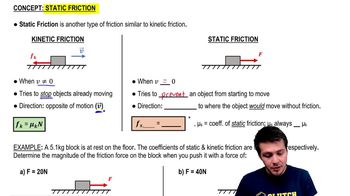Here are the essential concepts you must grasp in order to answer the question correctly.
Power and Efficiency
Power is the rate at which work is done or energy is transferred. In this context, the Porsche's engine produces 217 horsepower, but only 70% of this power is effectively used for acceleration due to losses in the engine and drivetrain. Understanding how power is converted into usable force is crucial for calculating the car's performance.
Recommended video:
Efficiency of a Nuclear Power Plant
Friction and Traction
Friction is the force that opposes the relative motion of two surfaces in contact. The coefficient of static friction (μₛ) indicates the maximum frictional force before sliding occurs. For the Porsche on a concrete surface with μₛ = 1.00, this frictional force is essential for determining how much of the engine's power can be converted into forward acceleration.
Recommended video:
Static Friction & Equilibrium
Newton's Second Law of Motion
Newton's Second Law states that the acceleration of an object is directly proportional to the net force acting on it and inversely proportional to its mass (F = ma). In this scenario, the net force is the frictional force that propels the car forward, and understanding this relationship is key to calculating the maximum acceleration of the Porsche.
Recommended video:
Intro to Forces & Newton's Second Law



